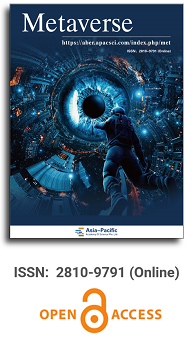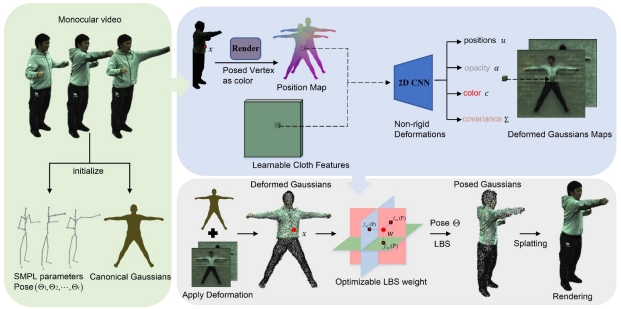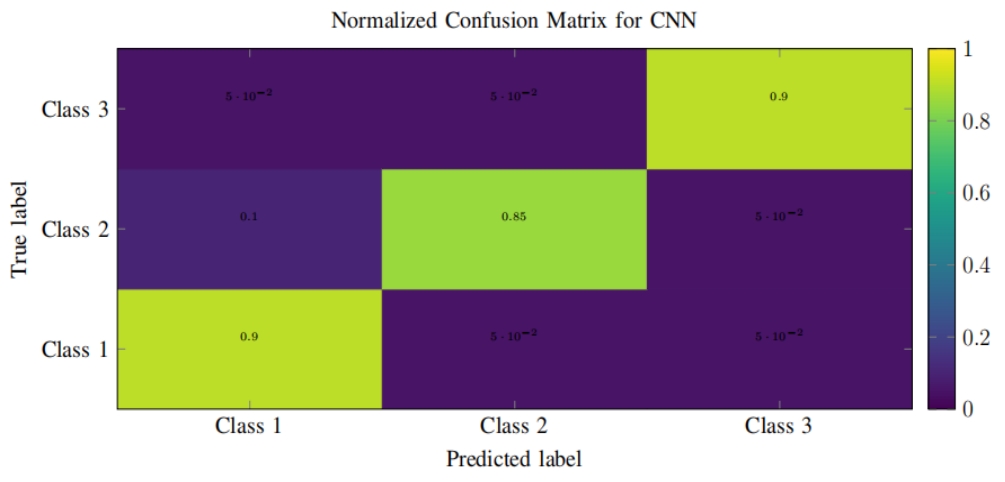
Asia Pacific Academy of Science Pte. Ltd. (APACSCI) specializes in international journal publishing. APACSCI adopts the open access publishing model and provides an important communication bridge for academic groups whose interest fields include engineering, technology, medicine, computer, mathematics, agriculture and forestry, and environment.



Issue release: 30 June, 2023
The editorial focuses on two topics: one is to explore the development of the Metaverse industry, and the other is to improve people’s understanding of the Metaverse.
Issue release: 30 June, 2023
In this issue, we are honored to feature a collection of articles from Professor James Hutson and his co-authors. Prof. James Hutson is an esteemed art history expert at Lindenwood University’s College of Arts and Humanities, whose recent interest is in AI generated art and the future potential for visual communication. He has provided us with a relatively comprehensive exploration of the Metaverse’s impact on education. In addition, he and his colleague also explored the ethical issues of the use of AI technologies, specifically the ethical considerations of digital necromancy. The decision to include four articles by the same author is a deliberate choice, reflecting the depth and breadth of Hutson’s research and the multifaceted nature of both the Metaverse in education and the possible ethical concerns of the use of AI technologies.
Issue release: 30 June, 2023
The integration of generative artificial intelligence (AI) tools in art and design has disrupted the traditional creative landscape, leading to debates on the legitimacy of AI-generated art and the emergence of new markets such as non-fungible tokens (NFTs). The US Copyright Office’s February 21, 2023, ruling withdrawing copyright protection for AI-generated comic artwork, while protecting the accompanying text and arrangement, highlights the contested nature of AI art and suggests that significant human intervention in the creative process will be required for monetization. Whether considered content interpolation or content creation, AI generative content for the creation of art and design is here with human-AI collaboration. To explore the potential of AI tools in creative practice, this study introduced students in a digital art course to Craiyon and Midjourney generative AI tools, with DALL-E 2 selected as the primary tool due to its varied output. The students were tasked with selecting a preferred prompt from one tool and then reproducing the output from both tools. The results revealed significant variations in replicating the outputs of different AI tools and limited exploration of prompt engineering, leading to restrictions in the iterative process of artmaking. The students agreed that generative AI tools are not a substitute for human creativity and should be used for final projects. The study demonstrates the potential and limitations of integrating AI tools in art and design and suggests the need for further research in developing effective prompt engineering strategies.
Issue release: 30 June, 2023
The rapid development and adoption of generative artificial intelligence (AI) tools in the art and design education landscape have introduced both opportunities and challenges. This timely study addresses the need to effectively integrate these tools into the classroom while considering ethical implications and the importance of prompt engineering. By examining the iterative process of refining original ideas through multiple iterations, verbal expansion, and the use of OpenAI’s DALL-E2 for generating diverse visual outcomes, researchers gain insights into the potential benefits and pitfalls of these tools in an educational context. Students in the digital at case study were taught prompt engineering techniques and were tasked with crafting multiple prompts, focusing on refining their ideas over time. Participants demonstrated an increased understanding of the potential and limitations of generative AI tools and how to manipulate subject matter for more effective results. The iterative process encouraged students to explore and experiment with their creative ideas, leading to a deeper understanding of the possibilities offered by AI tools. Despite acknowledging the ethical concerns regarding copyright and the potential replacement of artists, students appreciated the value of generative AI tools for enhancing their sketchbooks and ideation process. Through prompt engineering and iterative processes, students developed a more detail-oriented approach to their work. The challenge of using AI-generated images as final products was conceptually intriguing, requiring further investigation and consideration of the prompts. This study highlights the potential benefits and challenges of integrating generative AI tools into art and design classrooms, emphasizing the importance of prompt engineering, iterative processes, and ethical considerations as these technologies continue to evolve.
Issue release: 30 June, 2023
This research refers to the new information and communication technologies that have emerged in recent years and that are being used in education as a pedagogical resource. Thus, Metaverse have been applied in universities obtaining great benefits such as improving interaction and communication between students and teachers through personalized avatars regardless of the physical limitations of the real world, developing skills and abilities that encourage learning and immersion, leaving aside the traditionalist learning. The use of Metaverse in education aims to make the student the protagonist of his or her own learning and, in addition, seeks to improve collaborative learning to encourage active participation among students through the interaction of avatars within the Metaverse. As a practical alternative and an emerging trend, the tool “AltspaceVR” is proposed for higher education. The sample of this study consisted of 159 graduates between the ages of 18 and 35 who were pursuing their doctoral, bachelor’s, master’s or other studies, and 7 experts working as teachers in Spanish universities, including a doctor in educational methodologies who has been named “Professor of the Year” on several occasions. Among the main conclusions of the study we have obtained that students consider that the implementation of Metaverse in higher education will promote learning and immersion, allowing the development of pedagogical activities in a more innovative and interactive way thanks to its graphical interface. On the other hand, from the results of the survey we conclude that the teacher lacks knowledge to make adequate use of Metaverse as a pedagogical resource, using only two-dimensional and mainly verbal platforms that only generate a traditionalist and non-interactive learning.
Issue release: 30 June, 2023
This study investigates the potential of Virtual Learning Environments (VLEs) and digital twins to overcome geographical, scheduling, and diversity barriers in the training of secondary educational administrators. Recognizing the limitations in traditional in-person visits to schools-particularly for graduate students in rural areas and those working fulltime with dependents-and the current ethnic composition of educational administrators, where White individuals comprise 64.5% of the population in the US (71.01% for principals), this research explores how VLEs can democratize access and foster diversity in educational leadership training. Over the academic year 2022–2023, pre- and post-engagement surveys were administered to students in a Visionary and Innovative Leadership course that employed a digital twin of a middle school. The virtual environment allowed students to explore the school and interact with its mission and vision principles at their own pace, from any location, and as frequently as required. These digital tools not only offered a homogenous and repeatable experience but also enabled a deeper, self-directed investigation into how an institution’s mission and vision are operationalized within its physical environment. Findings from the study indicate that VLEs and digital twins offer considerable potential in terms of accessibility, flexibility, and diversity in educational leadership training. Through the integration of these innovative technologies, future leaders can experience immersive, interactive, and inclusive learning environments, contributing to a more diverse and effective educational leadership landscape.
Issue release: 30 June, 2023
What is the Metaverse actually? It is an important issue in the terms of theory and practice with huge controversy. Regarding the Metaverse from a philosophical point of view, it could better highlight the inner essence behind the controversy of representation. From the connotation view, it is a digital mapping and mirror world of universe. Extensively, it is a comprehensive integration of digital information technologies. In the view of philosophy, it is an artificial universe created by human beings with digital technology, which is digital universe corresponding to the real universe. In the view of spiritual philosophy, it is a cosmic brain created by human beings with wisdom of natural universe, which is a cosmic heart for the body of natural universe. In the view of cognitive philosophy, it is a digital universe that recognizes everything, and a digital laboratory for human innovation and creation.
Issue release: 30 June, 2023
The advancement of hardware and computing power has enabled deep learning to be used in a variety of fields, particularly in AI medical applications in intelligent medicine and medical metaverse. Deep learning models are aiding in many clinical medical image analysis tasks, including fusion, registration, detection, classification and segmentation. In recent years, many deep learning-based approaches have been developed for medical image recognition, including classification and segmentation. However, these models are susceptible to adversarial samples, posing a threat to their real world application and making them unsuitable for clinical use. This paper provides an overview of adversarial attack strategies that have been proposed against medical image models and the defense methods used to protect them. We assessed the advantages and disadvantages of these strategies and compared their efficiency. We then examined the existing state and restrictions of research methods involving the adversarial attack and defense of deep learning models for medical image recognition. Additionally, several suggestions were given on how to enhance the robustness of medical image deep learning models in intelligent medicine and medical metaverse.
Issue release: 30 June, 2023
This paper aims to study the concept of the metaverse as reflected in the Three-Body game in the TV series The Three-Body Problem, as well as the current development status of the metaverse in the real world. Firstly, the Three-Body game in The Three-Body problem is analyzed and explained to uncover the underlying metaverse knowledge. Then, through a literature review, the implementation and application scenarios of the metaverse in various industries are investigated from the databases Web of Science and Scopus, using keywords such as “metaverse”, “Three-Body”, “virtual world”, “virtual reality games”, and “human-computer interaction”. Nearly 10,000 relevant articles were retrieved, and 20 articles were selected for in-depth qualitative and quantitative analysis. Subsequently, the content of the literature is summarized from three aspects: the current development status of the metaverse, advancements in virtual reality technology, and advancements in human-computer interaction technology. The application status and technological progress of the metaverse in various industries and the existing technological limitations are discussed. By extending the concept of the metaverse from science fiction, this paper provides research ideas for the future development of the metaverse.
Issue release: 30 June, 2023
Geometric shape representation algorithms are key technologies in the fields of computer graphics and geometric modeling. The Medial Axis Transform (MAT) is an important geometric model description tool that provides a simplified representation of complex geometric shapes while ensuring accurate descriptions of geometric shape and topology. Therefore, it can meet the requirements of many modern research fields, including geometric modeling, pattern recognition, model segmentation, model deformation, physical simulation, path planning, and more. This paper first introduces the basic concept of the medial axis transform, including the definition of the medial axis transform and the concept of medial axis primitives. It then describes the extraction algorithms for the medial axis transform, specific research on the medial axis transform in computer vision and computer graphics, potential applications of the medial axis transform, and medial axis transform datasets. Finally, the disadvantages and advantages of the medial axis transform are discussed, and some suggestions on possible future research directions are presented.
Issue release: 30 June, 2023
This article explores the rise of generative AI, particularly ChatGPT, and the combination of large language models (LLM) with robotics, exemplified by Ameca the Robot. It addresses the need to study the ethical considerations and potential implications of digital necromancy, which involves using AI to reanimate deceased individuals for various purposes. Reasons for desiring to engage with a disembodied or bodied replica of a person include the preservation of memories, emotional closure, cultural heritage and historical preservation, interacting with idols or influential figures, educational and research purposes, and creative expression and artistic endeavors. As such, this article examines historical examples of the practice in hologram concerts, CGI characters, and others in order to analyze the ethical concerns related to privacy, consent, and commercial gain. It delves into the challenges of accurately representing individual personalities, misrepresenting cultural context, and the limitations of available data. Furthermore, it explores the Pet Cemetery conundrum and its impact on the grieving process, mental health, and the moral implications of using AI to generate interactions with the deceased. By contemplating future use cases like interactive virtual assistants and realistic historical reenactments, the article highlights the importance of addressing ethical implications as these technologies continue to advance and contributes to the discourse on the responsible and ethical use of generative AI, LLM, and robotics in the context of digital resurrection, calling for ongoing discussions and considerations of AI rights, social dynamics, and the grieving process.

Prof. Zhigeng Pan
Director, Institute for Metaverse, Nanjing University of Information Science & Technology, China

Prof. Jianrong Tan
Academician, Chinese Academy of Engineering, China
Metaverse Scientist Forum No.3 was successfully held on April 22, 2025, from 19:00 to 20:30 (Beijing Time)...
We received the Scopus notification on April 19th, confirming that the journal has been successfully indexed by Scopus...
We are pleased to announce that we have updated the requirements for manuscript figures in the submission guidelines. Manuscripts submitted after April 15, 2025 are required to strictly adhere to the change. These updates are aimed at ensuring the highest quality of visual content in our publications and enhancing the overall readability and impact of your research. For more details, please find it in sumissions...
On April 14, 2025, Prof. James Hutson from the United States delivered a lecture titled “Designing Neurosanctuaries in the Metaverse: Adaptive Virtual Spaces for Cognitive Restoration and Mental Health”...


 Open Access
Open Access




.jpg)

.jpg)

